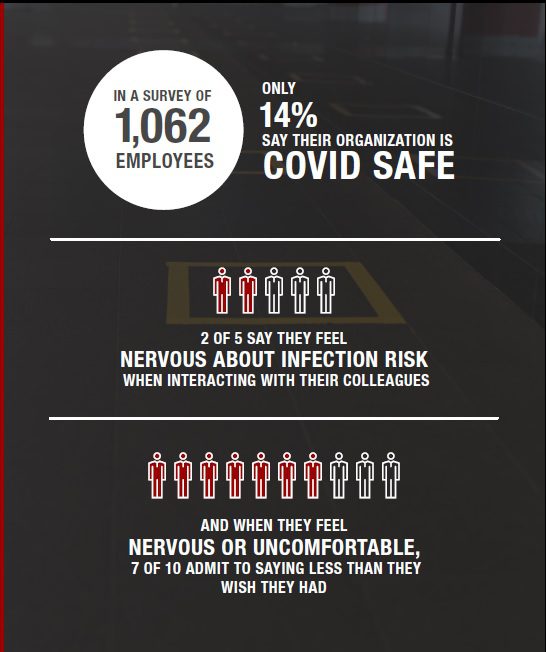

Sharing is caring!
5 Strategies for Success in an Ongoing Pandemic
As economies reopen, we’ll need more than safety masks and sanitizer to succeed.
“The health of any relationship, organization, or community is a function of the lag time between identifying and discussing problems.” Joseph Grenny
Open for Business
Open now, or later? As debate rages over when to restart economies, one critical element is absent from the discussion: business success will have less to do with when we open our doors and more to do with how often and well we open our mouths.
Our years of research and consulting have taught us that preventable harm is only prevented when people speak up. In fact, the findings from our research prompted VitalSmarts co-founder Joseph Grenny to conclude that “The health of any relationship, organization, or community is a function of the lag time between identifying and discussing problems.”
Yet, even in the midst of a deadly virus, we see that people hold their tongues frighteningly long, if they speak up at all. On May 3, 2020, at the peak of the COVID-19 pandemic, the Vice President of the United States, Mike Pence, entered the Mayo Clinic to learn about their COVID-19 research. During a lengthy tour provided by Mayo Clinic leaders, who all wore masks, Pence proceeded without a mask. And no one said a word.
There is evidence that simple behaviors can mitigate the risk of spreading COVID-19, even when in the close social quarters involved in running a business. For example, research shows that if employees wash their hands five times during a shift, transmission risk is reduced by as much as 45%.
Preventable harm is only prevented when people speak up.
One review of multiple studies suggests that if just two-thirds of us wore even marginally effective masks consistently, the epidemic could be stopped.
Business and community leaders have been implementing such measures to keep employees and customers safe. But most are doing little to ensure those measures become norms. Social regulation—a fancy way to describe speaking up—is the process by which ideals become norms. If noncompliance isn’t addressed, as happened at the Mayo Clinic, safe behavior becomes a social anomaly. Or, worse, a joke.
Successfully doing business in an ongoing pandemic will not only depend on masks, screening, hygiene and social distancing, but also, and perhaps most critically, on everyone adhering to these measures consistently. And that won’t happen unless people hold one another accountable, regardless of position or authority.
Here are five things leaders can do to create a culture of accountability.
We will successfully cultivate the new norms required for doing business in an ongoing pandemic to the degree we effectively hold one another accountable to those norms.
Successfully doing business in an ongoing pandemic won’t happen unless people hold one another accountable, regardless of position or authority.
“To be accountable means that we are willing to be responsible to another person for our behavior and it implies a level of submission to another’s opinions and viewpoints.” Wayde Goodall
1) Be Kind and Remind
Two-hundred percent accountability is the only way to create and sustain change. Employees must understand that they not only must follow safe practices themselves (the first 100%), they also must take responsibility for reminding others to do the same (the second 100%). Instruct employees that when ANYONE sees ANYONE violate safe practices, they are to remind them of proper protocol with a polite “please”.
That said, this norm won’t stand on its own. As recent incidents demonstrate, simple correction can quickly turn into confrontation, even violence. And this risk isn’t lost on those who might be asked to remind the Vice President of the United States. None is exempt from potentially taking offense.
2) Give Gratitude, Not Attitude
Everyone must be taught that, when reminded to follow new behaviors or protocol, there is only one acceptable response: an immediate “Thank you” followed by compliance. Period.
Spectrum Health in West Michigan, for example, worked for months to get doctors to wash their hands before and after every patient visit. But it was only after the norm of reminding was introduced that hand hygiene improved. In fact, it improved by more than 60% within a matter of weeks. But the practice of reminding didn’t stick until doctors were trained to “show gratitude, not attitude.” Only then did reminding them to comply become a low-risk norm rather than an intimidating or confrontational ordeal.
“So, what’s the first step to changing norms? It’s breaking the code of silence around the problem that always sustains the status quo.” Kerry Patterson
3) Launch a COVID Bootcamp
The best time to reset norms is when no one knows what is normal.
As employees reenter the workplace, take advantage of their unformed expectations by holding a bootcamp. This can be as short as 30 minutes or
as long as a few hours. The structure is simple: it should be led by leaders, introduce a moral framework, and allow everyone to practice the new behaviors.
Leader-Led
This bootcamp can’t be turned over to HR or pawned to an outside consultant. Organizational leaders must stand in front of employees and demonstrate their sincerity and commitment to new policies and practices.
Moral Framework
Make the case for changing behavior by telling stories of affected friends, family, or clients to bring the risks to life. This will help everyone see the moral cause or purpose. But to achieve this moral cause you’ll want to further frame the new norms in a positive light. For example, the first two practices—Be Kind and Remind, and Give Gratitude, Not Attitude—are much easier to follow when combined with a positive frame around accountability. Being held accountable often stings, and it’s this experience that leads people to associate holding others accountable with reproving, belittling, shaming, tattling, calling others out, and so on. Nip this negative viewpoint in the bud by reframing accountability for what it can and ought to be: a means to improve behavior, to lift others. When people learn to see holding one another accountable as a form of social support, in pursuit of a praiseworthy purpose, they are more likely to deliver and receive requests for compliance with kindness.
Deliberate Practice
Leaders must not simply instruct people on new safety behaviors, they must go through the actual motions of doing them. They must begin to develop muscle memory so the practices feel comfortable, normal, and compulsory. For example, at Spectrum Health, we developed a bootcamp where everyone in a unit would go through the motions of walking into and out of a patient room. In one condition, they would wash in and wash out as required. In another, they would fail to wash in, and another caregiver would practice reminding them. After which the one reminded would practice saying “Thank you” and complying. The entire exercise took no more than 20 minutes, but compliance with the new norms was substantially higher in units that did the bootcamp over those that didn’t.
“You can talk about results all you want, but they remain nothing more than ideas until you decide exactly how you’re going to measure them.” Joseph Grenny
4) Implement Inspections
As W. Edwards Deming said, “You don’t get what you expect, you get what you inspect.” Just like in a hospital, leaders must use a checklist to measure compliance. They should walk the work area and observe the degree to which proper behavior is being practiced. They then should score compliance, whether by team or department, each day for the first 30 days. This “rounding” should be done at unpredictable times of day. After a month, it can happen every other day. During this routine but random inspection, the point should be to observe and record, not police and enforce.
5)Keep a Scorecard
Leaders must post or share the compliance scores publicly, every day. Above the score, they might place a large circle with colors denoting whether the organization is compliant with the new norms.
For Example:


They must commit to post the results no matter what they are and make sure they are visible to clients and customers. Embarrassment is a powerful motivator for improvement.
Safety and Success Require More Than Hoarding Hand Sanitizer
While business success in coming months will require safety masks and sanitizer, that won’t be enough. It will also require a culture of 200% accountability—where everyone takes responsibility for their own compliance and responsibility for correcting anyone else whom they see deviating from healthy norms.
A recent study we conducted suggests that organizations have much room
for improvement. In a survey of 1,062 employees, only 14 percent say their organization is COVID safe. What’s more, 2 of 5 say they feel nervous about infection risk when interacting with their colleagues. And when they feel nervous or uncomfortable, 7 of 10 admit to saying less than they wish they had.
The new norms for safe social and business interaction won’t stick without norms of speaking up and holding others accountable. And yet, employees say their organizations are failing on both accounts.
After thirty years of studying what it takes to create rapid, profound and sustainable change, our central finding is that the speed with which norms change is the speed with which it becomes normal to give correction. The capacity to exert this kind of influence has never been more important.
Today it is not just the key to our physical survival, but to our economic survival as well. If leaders take these practices seriously, they will be able to inculcate new practices quickly, and ensure safe concepts turn into strong norms.


Build a Culture of Accountability
The health of our teams, organizations, and communities can be measured by the quality and speed with which people speak up and engage in dialogue. The skills to achieve a culture of accountability and dialogue are taught in these award-winning VitalSmarts programs.

